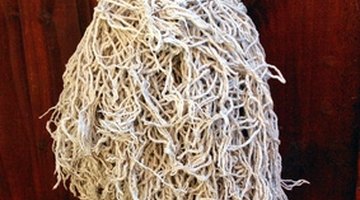The Effects of Water on Linoleum
Linoleum flooring is considered long-wearing and relatively easy to maintain. It's made from cork, powdered limestone, linseed oil and pine resins. That makes linoleum an environmentally friendly choice for flooring. It's also hypoallergenic and resists allergens, so you may not have to spend much time cleaning it. Often, you just can use water and vinegar to clean the floors. However, water in large amounts and standing water can damage the floors.
Discoloration

Linoleum is not recommended for use in bathrooms, because if the toilet, tub or sink overflows, the floor can easily become discolored. When water gets underneath linoleum flooring, the flooring becomes discolored. Nothing can be done to remove that stain once it's there. When mopping linoleum floors, always use just a damp, not wet, mop. Using a soaking-wet mop can cause water to be trapped between the linoleum and the subfloor.
Loosening
If water is left on linoleum for an extended period, the seams may begin to loosen. In addition, if you have linoleum tiles, they can begin lifting from the floor. Once that happens, the floor cannot be fixed. This usually only happens when the water sits on the floor for a long time. This type of damage does not occur with just surface water from mopping or cleaning.
Bubbles
While cleaning linoleum floors, you must take care to not scrub the them too vigorously and, of course, to not flood them with water. Besides causing discoloration, water can damage the linoleum and make it warp and bubble on the surface. After mopping your floor, you can allow it to dry naturally. However, if there are any remaining puddles of water, you should hand dry those with a towel.
References
Writer Bio
Yvonne Van Damme is a freelance writer based in Seattle. She has been writing for several years with a focus on criminal justice and legal topics. In addition to various websites, she has been published in several academic journals. Van Damme holds a Bachelor of Arts in law, society and justice and sociology from the University of Washington.
Photo Credits
- mop head image by green308 from Fotolia.com
More Articles



